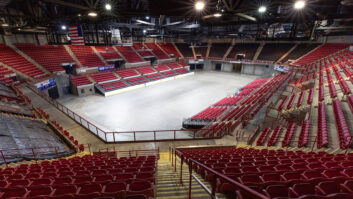Checking the Schematic
Feb 1, 1998 12:00 PM,
Ken Lopez
Change is always around the corner and yet constantly with us. The systemscontracting industry is undergoing fundamental change that will ultimatelyaffect all those who call it home. Included in the whirlwind aremanufacturers, consultants, representatives, systems contractors andintegrators, and even customers. All are faced with a degree of complexityand rapidity of change that can be daunting.
One of the driving forces of this change is technology. The familiar analogdevices of the past are rapidly giving way to digital audio, digital signalprocessing, digital switching, digital routing, and digital systemsconfiguration. This new and promising technology exerts a profound impactnot only on the systems that are being designed and implemented, but alsoon the fundamental functions and processes of the industry. The waybusiness is organized and carried out is being changed by the tools we use.
It is common to interact with a broad array of individuals and institutionsduring the cycle of a project. A complex set of working relationships mustbe forged with customers, consultants, governmental agencies, regulatorybodies, manufacturers, manufacturerOs representatives, general andsub-contractors and even competitors. The list is seemingly endless andcontinues to grow with each new project.
Moreover, fundamental relationships among key players are getting moredifficult to maintain. The relationships we rely upon may themselves may bechanging. The goal of this short article is to question and raise ourawareness of the potential of change. We must begin to exercise thevisionary within us if we are to maximize those potentials.
Common differencesThe key to successful relationships often lies in understanding thedifferent points of view involved. If the fundamental forces that shape anassociateOs view of the world can be understood, the first steps to aworking relationship can be taken. It is important to realize that systemscontractors, manufacturers and representatives do not often share the samepoint of view or even the same definition of terms.
Manufacturers look out at the world searching for opportunity. Theirnominal function is to provide goods and services to the marketplaces inneed of them and thereby make a profit. They exist to fill market needs byunifying capital resources, materials, labor and expertise in the creationof new products. A few leaders will also add vision.
Most business ventures feel a need to categorize and compartmentalize theworld into markets to understand their needs and the potential foropportunity. This categorization is done in an attempt to create order outof the chaos of the marketplace. Once the markets are categorized and therelevant opportunities chosen, product development can begin. In MBAterminology, this is called market segmentation and targeting.
Systems contractors and consultants tend to look at the world as a seriesof challenges and opportunities embodied in the projects they confront. Theworld is a design/build opportunity. They are usually in search of systemsolutions to problems that are also systemic in nature. Solutions andknowledge are the true commodities. Products are only a component of thesolution, yet product development is often the focus. Thankfully, moremanufacturers are taking the solution approach. A few even exercise theirvisionary tools and have come to understand that new creations have thepotential to redefine the markets they serve.
Additionally, a potential point of confusion arises when the term OmarketOis used because multiple definitions are possible. Markets may be definedgeographically to describe distinct geographical areas, such as a country,region, state, province or metropolitan area. Markets are often defined bydemographic classification of human populations based on age, gender,occupation and income. Markets may also be defined as the professional enduser of the product or service, such as houses of worship, conferencecenters, schools, theme parks, or lodging and gaming facilities. Lastly,markets are defined in terms of the distribution channel, or the path theproduct takes to the end- user, such as the contracting market.
When a manufacturer says it is market driven, what is really meant? Whencontractors speak of the markets they serve, which definition of the wordare they using? These are not academic questions. Many manufacturers anddealers have not clearly determined their target markets, and as a result,they are never really successful because they are not focused properly.
Product developmentIn the early decades of the industry, most manufacturers specializing inprofessional audio products focused on one or two market segments. In the70s, the power of popular music and the technology to create and reproduceit began to have a major impact on the professional audio industry. Asimprovements were made in the recording chain, the demands on thereproduction chain increased. Sound- reinforcement systems evolved fromspeech-range systems to full-range, high-level entertainment systems, andmanufacturers worked to create new products to meet these new demands.
As new companies continue to enter the marketplace, competitive pressuresescalate, and the cycle of productdevelopment quickens. Gone are the dayswhen dealers memorized model numbers with the secure notion that they wouldbe good for ten years or more. New products and new technologies now arriveat a dizzying pace, with new brand names, manufacturers and carbon-copyproducts arriving in record numbers. How many clones of a popular compactmixer or popular loudspeaker are necessary, and does the market need them?Why do dealers support these companies? A visit to any major trade showwill bring this point into focus.
There are now dozens of manufacturers of loudspeakers, mixing consoles,microphones, power amplifiers and signal-processing equipment. Recording,editing, measurement, interconnection and presentation equipment have beenrecently transformed with the influence of new technologies. Applying newtechnologies to the creation of new products fuels competition as eachcompany attempts to beat the others to market with the latest features andlower price points.
Distribution and salesOnce markets are targeted and products are developed, the manufacturer isfaced with the need to develop a contractor-dealer network. Establishingand servicing this network is time consuming and difficult. It can takeyears to develop a truly functional network. Although retail dealercounterparts may be worried about being replaced by chain stores, catalogsand the Internet, contractors can rest assured that design and installationare, for the foreseeable future, still needed. Manufacturers must have along-term outlook and commitment to bring the necessary resources to thetable.
Sales revenue is the life blood of the business, but unlike the retailmarkets, system projects can take months or years to develop into apurchase order. Many manufacturers sell identical or similar products tothe retail music markets to generate more immediate sales returns, whichcan help subsidize commercial product lines. More significantly, newtechnologies and products developed for other professional marketplaces maysoon find their place in the systems market. This can become a double-edgedsword. To justify the development and marketing costs that mainstreamretail products demand, sufficient sales must be generated. The quest for asuccessful product consumes a large portion of a company’s competitiveresources.
The development of the network is crucial to a successful sales andmarketing plan. So, you might ask, what do manufacturers look for in adealer? Dealer performance (sales) and qualifications dominate the thinkingof most sales management. Financial stability and the ability to mount acomprehensive sales effort with the requisite management skills are high onthe list of desirable dealer qualities. Engineering and technical expertiseare of increasing importance because of the rising complexity of systems.Finding and creating a relationship with qualified systems contractors overa broad area such as the continental United States can be a hugeundertaking that outstrips the resources of most factory sales forces. Whomakes these important decisions?
The manufacturer’s representativeThe manufacturer’s representative is ultimately responsible for creatingand maintaining the contractor-dealer network and a great deal more. As thefactory struggles to win the product development and marketingcompetitions, they usually abdicate the work on the street to the factoryrepresentative.
The representative is much maligned when things are not going well. Whenthe problems have been solved, the dust has settled, and the project isdeclared a success, the representative rarely gets any credit. As resourcesfor the systems contractor, they are unequaled, yet they are overworked andunderused.
How did the manufacturer’s representative become the industry lightningrod? It is a function of the service they provide and the pivotal positionthey occupy in the chain of distribution. Most manufacturers assume thatthe representative works for them because they are paid by salescommissions. Most dealers assume the same, but the reality is somewhatdifferent.
Representatives often become the catalyzing agent among the salesdepartment, the contractor, the consultant, the customer, the creditdepartment, the shipping department, the local bureaucracy and a legion oflesser players in the completion of the typical complex project. In short,they become indispensable to the process and the players.
The representative’s prime concern is the establishment and maintenance ofa functional network of dealers. These dealers serve a diverse array ofmarkets for many manufacturers. Carefully choosing dealers who can competeand coexist is a delicate task considering the variables of close physicalproximity, multiple market segments, product-placement decisions, technicalcomplexities and competitive pressures. To accomplish this impossible taskrequires patience, market and product knowledge and a sense of thepolitical geography, and it requires living in the territory. No factorysalesperson in some distant city can ever fill the bill.
In addition to the constant maintenance of controlled distribution, thereare the daily details that contribute to getting it done – ten calls to thefactory for literature and twenty calls to the credit department and thedealer so that the order on hold will be shipped today. There are morecalls about technical details, application information, shipping dates,stocking and delivery. It is these administrative tasks that get the jobdone.
As important as they are, however, there are far more crucial tasks toaccomplish. Is it not time for manufacturers to bring modern communicationstechnology to bear on these issues? The valuable resources of therepresentative sales force should be used elsewhere.
Making choicesOne of the most important functions exercised on behalf of dealers is thatof choosing products. The market and product knowledge that is gathered andhoned over many years in the field comes into play when the time comes topick product lines to represent. In this process of choice, the dealer issaved a great deal of research and analysis.
Representatives are often called upon by the factory to pioneer new productlines. They must estimate its applicability to the market, solicit theappropriate dealers and get the product tested, specified, sold andinstalled.
When a dealer comes upon a challenge that requires a unique productsolution, the call often goes to the representative. The same is true forthe consultant who may not work with audio on a regular basis. Whenupdating is required on product files or new product offerings, they callon the representative.
Dealers often benefit from incidental aspects of their relationship withtheir representative. Experience, stability and perspective come with along career in the field. Often, the representative will outlast salesmanagers, presidents and even companies.
I was once told that manufacturers and management come and go, but theterritory and the dealers will always be here. In the long run, I work forthem and the customer. This means that the representative is often the mostpowerful ambassador to the factory. Make use of this valuable resource tohave your voice heard and acknowledged.
With the escalating blitz of new technologies and products, learning abouttechnical details and applications in real-world situations can bedifficult at best. Manufacturers once took it upon themselves to ensure ageneral level of knowledge and expertise industry wide. They often providedthe technical context of system design, electronics, acoustics andinstallation techniques.
The cost and diversion of the competitive effort leaves little time and fewresources for training and education. It is true that many companiesprovide adequate technical information for specific products, and theInternet is a great resource for delivering this information on demand.Sadly, the typical factory seminars of old are rarely held today. Out ofnecessity, the focus is often on products and features.
We are faced with a wholesale change in the technologies of our trade.Systems contractors, manufacturers, representatives, consultants andend-users all share in the need for updated technical knowledge. They willalso share in the benefits should this knowledge be made available.
Who assumes this responsibility? Private educational enterprises and ahandful of universities do their part. Industry organizations such as NSCAare stepping up with their own technical certification and educationalprograms. S&VC has developed its course, “Technical Fundamentals of Audio.”We must, however, do more. We need a concerted, coordinated, industry-wideeffort. The resources, business and profit potential to justify theirdeployment surely exist.
A knowledge conduit already exists in the form of the representativenetwork, through which local technology shows for their knowledge-hungrydealers are presented. Combined effort among all the key players could go along way to bridging the knowledge gap as it develops. More importantly, anenhanced level of industry-wide knowledge will enable us to evolve andcapitalize on the emerging systems market of the future. All it takes isvision.








